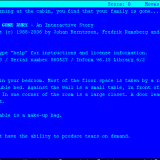Gaming, “In the Clouds”
By gamezombie 2 Comments
For the most part, the gaming community expects new hardware from three companies: Sony, Nintendo, and Microsoft (duh). If you really take an objective step back, you’ll come to realize that Microsoft really only got their foot in the console-gaming door within the past decade. Not to be personally nostalgic, but I can remember being deeply divulged in my Playstation 2 when one of my friends bought one of the clunky, all-too mysterious XBOX’s. I didn’t know what to think of the machine- “does it play Crash Bandicoot? Why are the buttons not labeled with shapes?!” My point being that new machines and hardware are hard to accept, hard to integrate into gamer’s lives. We’re conditionally trained to be fans of the tried and true, the old and the bold, the-okay, I’ll stop. Plainly said, it’s difficult to pull the average consumer away from their loyalties. That being said, I was thoroughly surprised when OnLive, a potential console competitor, arrived on the scene.
OnLive hopped onto the gamer’s radar just a couple of years ago, introduced first in the pages of subscription magazines and internet threads. I considered the new hardware to be something akin to Back to the Future’s theory that hoverboards would be abundant in the new millennium- it simply just wasn’t going to happen. However, in the year 2011 (just in case you didn’t know) I find that OnLive is very aLive topic. The company released their hardware this year and have even been dabbling in ‘app’ services for various mobile devices. Their business model seems to be, for lack of a better word, a bit of a clusterfuck, though. For the past couple months, they’ve been spouting promises of “$10 a month ‘service packs’” and free hardware deals with any purchase of such and so many games. They’ve also revealed that their hardware is to be built into new Vizio TV’s and Blu-ray players. Here’s my question: what the fuck are they trying to sell?! In some deals, they’ve given away free games; in others, they’ve given away free hardware. To my knowledge, the company hasn’t gone under yet (as they are acquiring more titles and continue to promote), but I don’t see how they’ve made any cash flow as of yet.
The clusterfuck doesn’t stop at the company’s style of business, though. Their gaming library, and the organization within, leaves something to be desired (I know, I know, they are just starting up). Thus far, OnLive has 38 confirmed titles, the highlights being F.E.A.R. 2, Bioshock, LEGO Batman, and on the arcade/indy side,World of Goo. Therein lies a couple concerns: 1.) In what manner were these games decided upon? 2.) Bioshock and F.E.A.R. 2 seem to cater to a niche audience- I think it’s a little bold entice consumers with games which were generally well received by only a few gamers, and 3.) Just LEGO Batman- was the shittiest installment selected on purpose, or was it given away to test OnLive’s waters?
The other thing OnLive should consider: history’s a reference- use it. Other than Microsoft (which was well-established even before the XBOX), few companies have been able to pull our new, successful hardware while introducing their name at the same time. Neo Geo, Atari’s attempt at self-resurrection (the Jaguar), and TurboGrafx all failed miserably when trying to enter the console market. Their prices were unaffordable or ill-understood, their libraries left everything to be desired, and their names had nothing to do with Sega or Nintendo. Sound familiar?
I respect what OnLive is setting out for, really I do. They’ve set up a market (or are trying/have tried/still figuring things out…) where gamers can play high-resolution ports of popular games for a fair price (when they figure out exactly what that is). The other advantage they’ve pitched is their ability to store your games “in the clouds.” Gamers would essentially have whole libraries of games which required no physical memory card on which to store the game itself or the saves made within the game. I suppose the overall “edge” this gives them is the lack of necessity for physical hardware (besides for the console itself)? On the whole, I don’t see this as a turning point for most consumers. Both the 360 and the PS3 offer this as well and none of my friends, at least, seem to take hearty advantage of it. With OnLive, however, my supposition is that one would have infinite amounts of storage available, unless they could figure out a business model in which gamers paid for the memory space in a subscriber-based, incremental fashion.
As always, only time will tell whether OnLive really takes off or not. In ten years, we could all be thinking fondly of the console that was, selling its exclusive titles (assuming OnLive gains any) on what we would contemporarily consider to be our WiiWare-just as we do for many Turbografx games and others who’ve been lost over the course of time. On the other hand, we could also be, futuristically speaking, gamers considering which of the four game consoles to invest in come Christmas 2021, assuming OnLive takes the reigns of fourth console champion. In an age where new gizmos are just around the corner on seven-sided buildings, we’ll just have to see.
Comment below if you or a friend has experienced OnLive, have some conflicting opinion I’d like to argue against, or just want to post funny emoticons.
-JP
